Case Study Analysis: Pediatric Nursing and Dehydration Management
VerifiedAdded on 2022/10/01
|8
|1819
|17
Case Study
AI Summary
This case study examines the nursing care of a 12-month-old child, Yasmin, who presented with dehydration due to diarrhea. The assignment addresses essential aspects of pediatric nursing, including communication techniques, safety considerations during hospitalization, and the identification of dehydration symptoms. It differentiates between mild, moderate, and severe dehydration, emphasizing the importance of early intervention. The case study also explores the relationship between diarrhea, electrolyte imbalance, and dehydration, alongside methods for treating dehydration. Priority nursing actions for Yasmin are discussed, highlighting the need for fluid administration, infection control, and fever management. The analysis underscores the critical role of parents and caregivers in recognizing early signs of dehydration to prevent severe complications. The assignment utilizes credible sources and follows APA 6th edition guidelines. This case study offers valuable insights into pediatric nursing practice, providing a comprehensive understanding of the assessment, management, and prevention of dehydration in children.
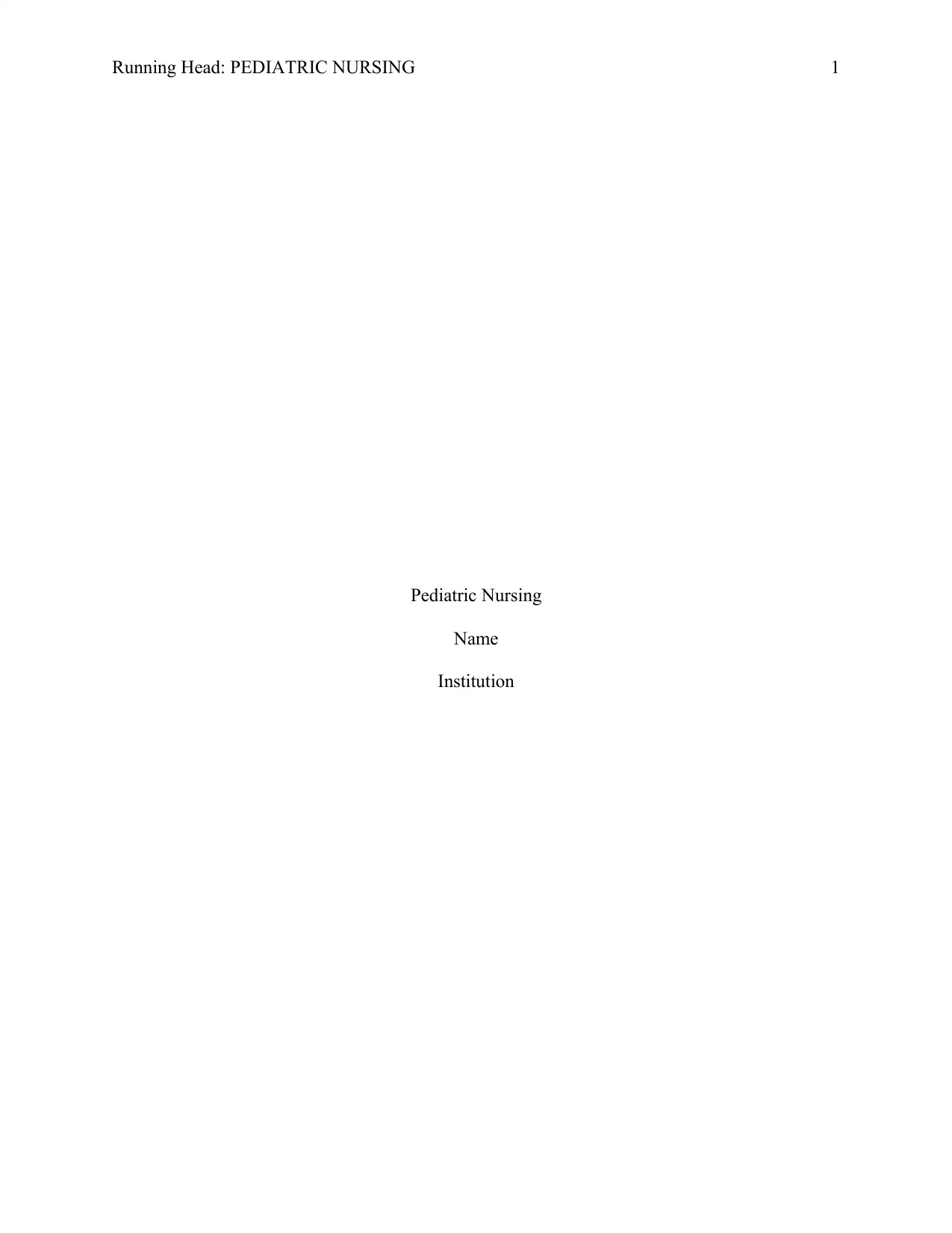
Running Head: PEDIATRIC NURSING 1
Pediatric Nursing
Name
Institution
Pediatric Nursing
Name
Institution
Paraphrase This Document
Need a fresh take? Get an instant paraphrase of this document with our AI Paraphraser
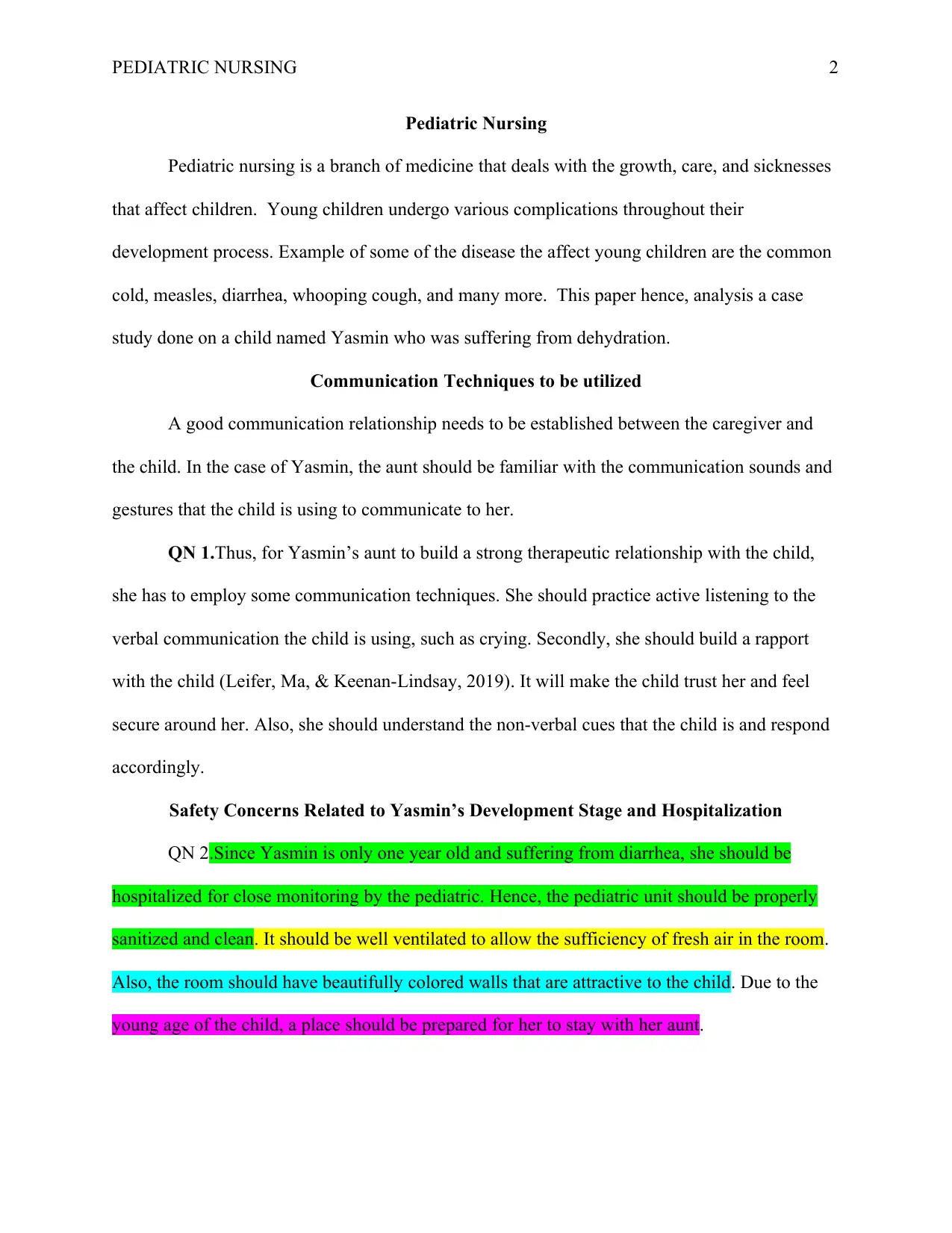
PEDIATRIC NURSING 2
Pediatric Nursing
Pediatric nursing is a branch of medicine that deals with the growth, care, and sicknesses
that affect children. Young children undergo various complications throughout their
development process. Example of some of the disease the affect young children are the common
cold, measles, diarrhea, whooping cough, and many more. This paper hence, analysis a case
study done on a child named Yasmin who was suffering from dehydration.
Communication Techniques to be utilized
A good communication relationship needs to be established between the caregiver and
the child. In the case of Yasmin, the aunt should be familiar with the communication sounds and
gestures that the child is using to communicate to her.
QN 1.Thus, for Yasmin’s aunt to build a strong therapeutic relationship with the child,
she has to employ some communication techniques. She should practice active listening to the
verbal communication the child is using, such as crying. Secondly, she should build a rapport
with the child (Leifer, Ma, & Keenan-Lindsay, 2019). It will make the child trust her and feel
secure around her. Also, she should understand the non-verbal cues that the child is and respond
accordingly.
Safety Concerns Related to Yasmin’s Development Stage and Hospitalization
QN 2.Since Yasmin is only one year old and suffering from diarrhea, she should be
hospitalized for close monitoring by the pediatric. Hence, the pediatric unit should be properly
sanitized and clean. It should be well ventilated to allow the sufficiency of fresh air in the room.
Also, the room should have beautifully colored walls that are attractive to the child. Due to the
young age of the child, a place should be prepared for her to stay with her aunt.
Pediatric Nursing
Pediatric nursing is a branch of medicine that deals with the growth, care, and sicknesses
that affect children. Young children undergo various complications throughout their
development process. Example of some of the disease the affect young children are the common
cold, measles, diarrhea, whooping cough, and many more. This paper hence, analysis a case
study done on a child named Yasmin who was suffering from dehydration.
Communication Techniques to be utilized
A good communication relationship needs to be established between the caregiver and
the child. In the case of Yasmin, the aunt should be familiar with the communication sounds and
gestures that the child is using to communicate to her.
QN 1.Thus, for Yasmin’s aunt to build a strong therapeutic relationship with the child,
she has to employ some communication techniques. She should practice active listening to the
verbal communication the child is using, such as crying. Secondly, she should build a rapport
with the child (Leifer, Ma, & Keenan-Lindsay, 2019). It will make the child trust her and feel
secure around her. Also, she should understand the non-verbal cues that the child is and respond
accordingly.
Safety Concerns Related to Yasmin’s Development Stage and Hospitalization
QN 2.Since Yasmin is only one year old and suffering from diarrhea, she should be
hospitalized for close monitoring by the pediatric. Hence, the pediatric unit should be properly
sanitized and clean. It should be well ventilated to allow the sufficiency of fresh air in the room.
Also, the room should have beautifully colored walls that are attractive to the child. Due to the
young age of the child, a place should be prepared for her to stay with her aunt.
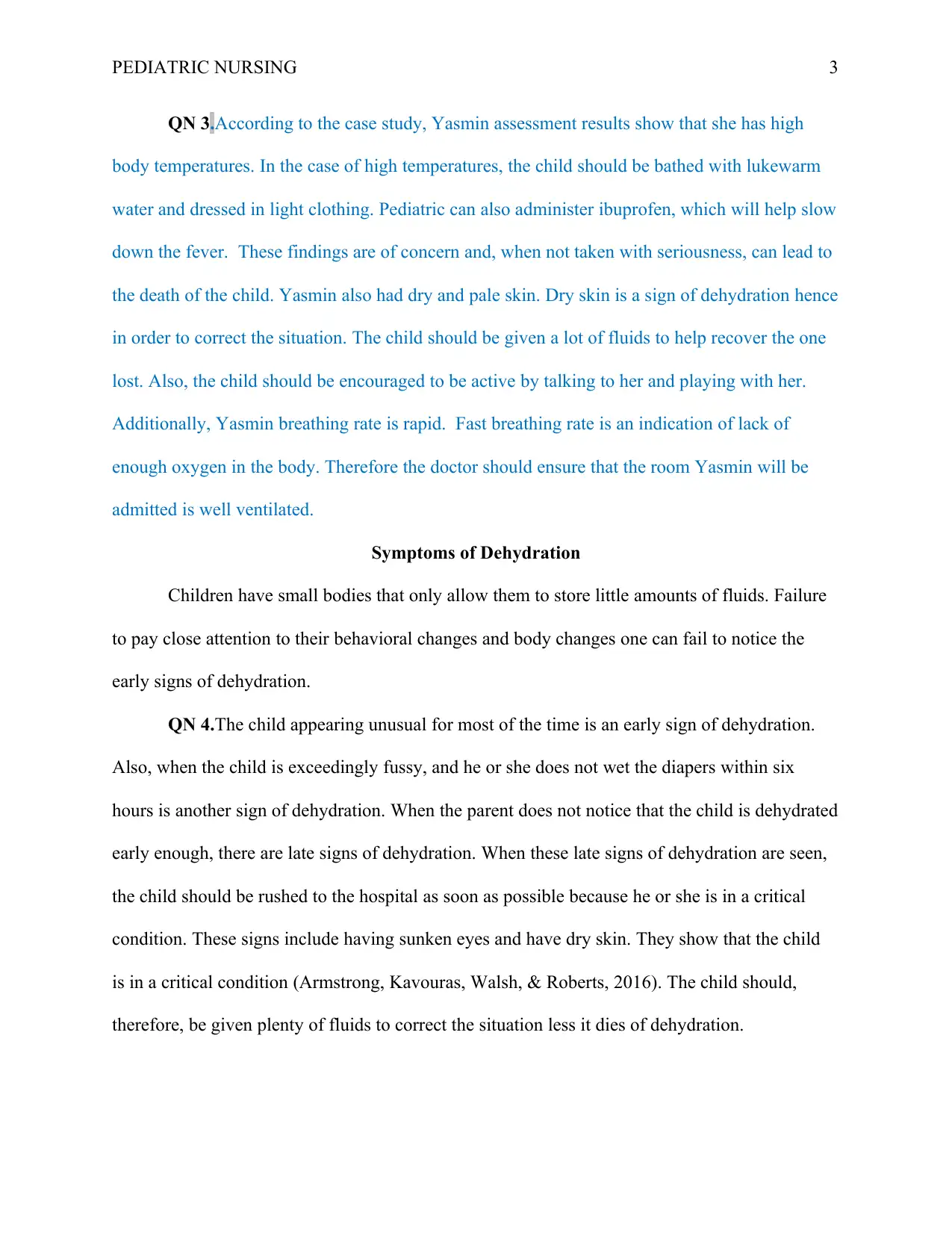
PEDIATRIC NURSING 3
QN 3.According to the case study, Yasmin assessment results show that she has high
body temperatures. In the case of high temperatures, the child should be bathed with lukewarm
water and dressed in light clothing. Pediatric can also administer ibuprofen, which will help slow
down the fever. These findings are of concern and, when not taken with seriousness, can lead to
the death of the child. Yasmin also had dry and pale skin. Dry skin is a sign of dehydration hence
in order to correct the situation. The child should be given a lot of fluids to help recover the one
lost. Also, the child should be encouraged to be active by talking to her and playing with her.
Additionally, Yasmin breathing rate is rapid. Fast breathing rate is an indication of lack of
enough oxygen in the body. Therefore the doctor should ensure that the room Yasmin will be
admitted is well ventilated.
Symptoms of Dehydration
Children have small bodies that only allow them to store little amounts of fluids. Failure
to pay close attention to their behavioral changes and body changes one can fail to notice the
early signs of dehydration.
QN 4.The child appearing unusual for most of the time is an early sign of dehydration.
Also, when the child is exceedingly fussy, and he or she does not wet the diapers within six
hours is another sign of dehydration. When the parent does not notice that the child is dehydrated
early enough, there are late signs of dehydration. When these late signs of dehydration are seen,
the child should be rushed to the hospital as soon as possible because he or she is in a critical
condition. These signs include having sunken eyes and have dry skin. They show that the child
is in a critical condition (Armstrong, Kavouras, Walsh, & Roberts, 2016). The child should,
therefore, be given plenty of fluids to correct the situation less it dies of dehydration.
QN 3.According to the case study, Yasmin assessment results show that she has high
body temperatures. In the case of high temperatures, the child should be bathed with lukewarm
water and dressed in light clothing. Pediatric can also administer ibuprofen, which will help slow
down the fever. These findings are of concern and, when not taken with seriousness, can lead to
the death of the child. Yasmin also had dry and pale skin. Dry skin is a sign of dehydration hence
in order to correct the situation. The child should be given a lot of fluids to help recover the one
lost. Also, the child should be encouraged to be active by talking to her and playing with her.
Additionally, Yasmin breathing rate is rapid. Fast breathing rate is an indication of lack of
enough oxygen in the body. Therefore the doctor should ensure that the room Yasmin will be
admitted is well ventilated.
Symptoms of Dehydration
Children have small bodies that only allow them to store little amounts of fluids. Failure
to pay close attention to their behavioral changes and body changes one can fail to notice the
early signs of dehydration.
QN 4.The child appearing unusual for most of the time is an early sign of dehydration.
Also, when the child is exceedingly fussy, and he or she does not wet the diapers within six
hours is another sign of dehydration. When the parent does not notice that the child is dehydrated
early enough, there are late signs of dehydration. When these late signs of dehydration are seen,
the child should be rushed to the hospital as soon as possible because he or she is in a critical
condition. These signs include having sunken eyes and have dry skin. They show that the child
is in a critical condition (Armstrong, Kavouras, Walsh, & Roberts, 2016). The child should,
therefore, be given plenty of fluids to correct the situation less it dies of dehydration.
⊘ This is a preview!⊘
Do you want full access?
Subscribe today to unlock all pages.

Trusted by 1+ million students worldwide
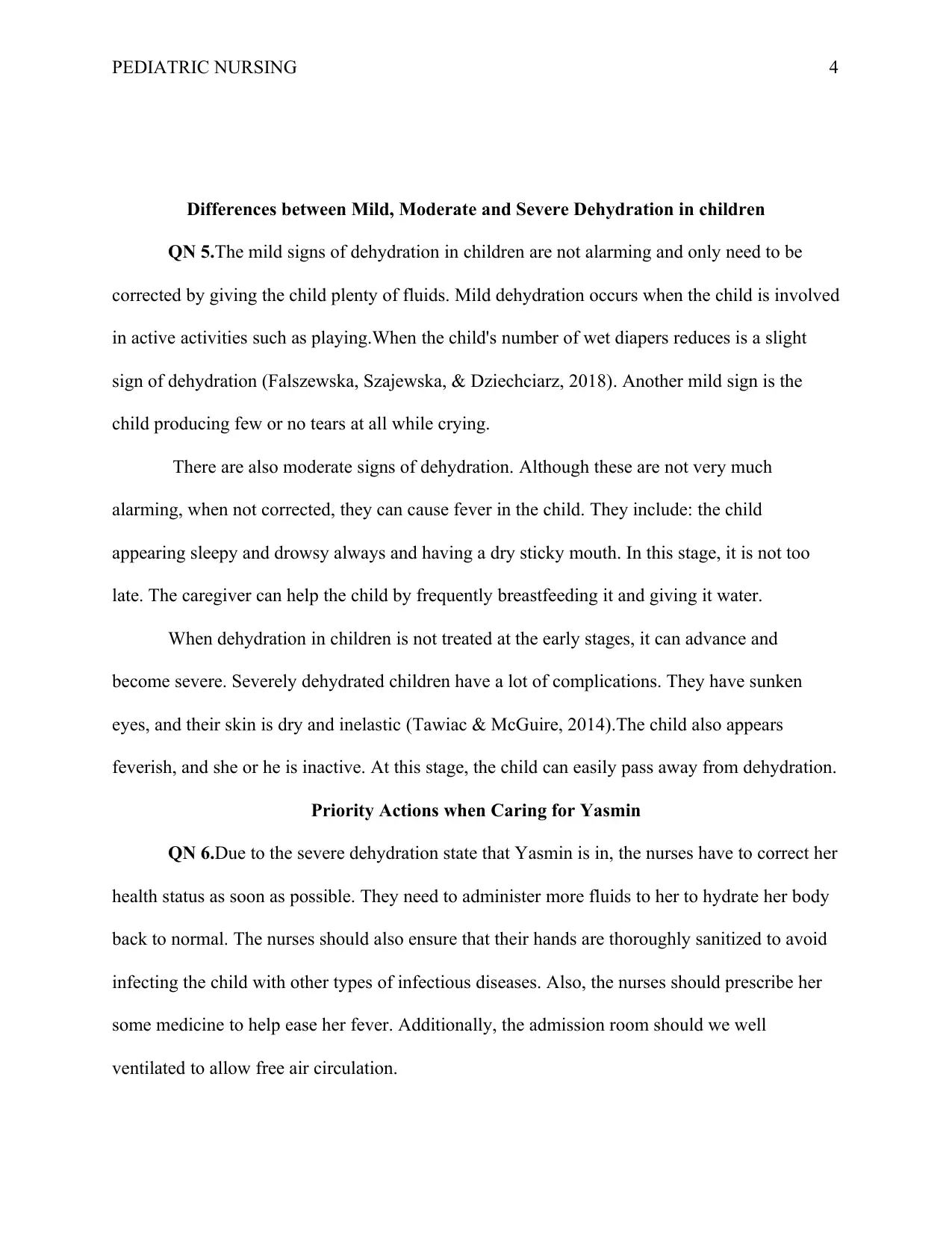
PEDIATRIC NURSING 4
Differences between Mild, Moderate and Severe Dehydration in children
QN 5.The mild signs of dehydration in children are not alarming and only need to be
corrected by giving the child plenty of fluids. Mild dehydration occurs when the child is involved
in active activities such as playing.When the child's number of wet diapers reduces is a slight
sign of dehydration (Falszewska, Szajewska, & Dziechciarz, 2018). Another mild sign is the
child producing few or no tears at all while crying.
There are also moderate signs of dehydration. Although these are not very much
alarming, when not corrected, they can cause fever in the child. They include: the child
appearing sleepy and drowsy always and having a dry sticky mouth. In this stage, it is not too
late. The caregiver can help the child by frequently breastfeeding it and giving it water.
When dehydration in children is not treated at the early stages, it can advance and
become severe. Severely dehydrated children have a lot of complications. They have sunken
eyes, and their skin is dry and inelastic (Tawiac & McGuire, 2014).The child also appears
feverish, and she or he is inactive. At this stage, the child can easily pass away from dehydration.
Priority Actions when Caring for Yasmin
QN 6.Due to the severe dehydration state that Yasmin is in, the nurses have to correct her
health status as soon as possible. They need to administer more fluids to her to hydrate her body
back to normal. The nurses should also ensure that their hands are thoroughly sanitized to avoid
infecting the child with other types of infectious diseases. Also, the nurses should prescribe her
some medicine to help ease her fever. Additionally, the admission room should we well
ventilated to allow free air circulation.
Differences between Mild, Moderate and Severe Dehydration in children
QN 5.The mild signs of dehydration in children are not alarming and only need to be
corrected by giving the child plenty of fluids. Mild dehydration occurs when the child is involved
in active activities such as playing.When the child's number of wet diapers reduces is a slight
sign of dehydration (Falszewska, Szajewska, & Dziechciarz, 2018). Another mild sign is the
child producing few or no tears at all while crying.
There are also moderate signs of dehydration. Although these are not very much
alarming, when not corrected, they can cause fever in the child. They include: the child
appearing sleepy and drowsy always and having a dry sticky mouth. In this stage, it is not too
late. The caregiver can help the child by frequently breastfeeding it and giving it water.
When dehydration in children is not treated at the early stages, it can advance and
become severe. Severely dehydrated children have a lot of complications. They have sunken
eyes, and their skin is dry and inelastic (Tawiac & McGuire, 2014).The child also appears
feverish, and she or he is inactive. At this stage, the child can easily pass away from dehydration.
Priority Actions when Caring for Yasmin
QN 6.Due to the severe dehydration state that Yasmin is in, the nurses have to correct her
health status as soon as possible. They need to administer more fluids to her to hydrate her body
back to normal. The nurses should also ensure that their hands are thoroughly sanitized to avoid
infecting the child with other types of infectious diseases. Also, the nurses should prescribe her
some medicine to help ease her fever. Additionally, the admission room should we well
ventilated to allow free air circulation.
Paraphrase This Document
Need a fresh take? Get an instant paraphrase of this document with our AI Paraphraser

PEDIATRIC NURSING 5
Relationship between Diarrhea, Electrolyte Imbalance and Dehydration
QN 7.Diarrhea is a state where the body abnormally secretes water and salts in the form
of a watery stool. The watery stool contains sodium chloride and potassium bicarbonate, water,
and electrolytes (Alam et al., 2015). The water and salts lost from the body result in dehydration.
Electrolyte imbalance, on the other hand, occurs from loss of salts from the body such as sodium,
potassium, chloride, and carbonate, which are lost together with water.
Methods of Treating Dehydration
For that reason, there is a need to treat dehydration and diarrheas in small children less
many of them die from it. There are common methods that are used to treat these disorders.
QN 8.One of the commonly used ways is breastfeeding the child and giving it a lot of
fluids that contain sugar solutions (Digre, Simpson, calyx, Lartey, Moodley, & Diop, 2016).
These help to restore body fluids and the salts. Another method used is the doctors put a tube
into the veins of the child. Fluids are therefore administered through that tube to hydrate the
child. Another way used is through delivering antibiotics — this helps to kill the bacteria that
might have caused the illness.
QN 9.In the case of Yasmin, the pediatric can use other methods rather than oral to
administer antipyretics. The doctor can opt to give her an injection of the same. Also, he or she
can form a solution of the antipyretic and mix it with the fluids being given to the child.
QN 10.After the child has received medical care from the pediatric; it begins to show
some improvements. These include the child's number of wet diapers increases; the child
becomes active and not always sleepy (Tam, Wong, Plint, Lepage, & Filler, 2014). The skin of
the child also becomes elastic, and the lips become well hydrated.
Conclusion
Relationship between Diarrhea, Electrolyte Imbalance and Dehydration
QN 7.Diarrhea is a state where the body abnormally secretes water and salts in the form
of a watery stool. The watery stool contains sodium chloride and potassium bicarbonate, water,
and electrolytes (Alam et al., 2015). The water and salts lost from the body result in dehydration.
Electrolyte imbalance, on the other hand, occurs from loss of salts from the body such as sodium,
potassium, chloride, and carbonate, which are lost together with water.
Methods of Treating Dehydration
For that reason, there is a need to treat dehydration and diarrheas in small children less
many of them die from it. There are common methods that are used to treat these disorders.
QN 8.One of the commonly used ways is breastfeeding the child and giving it a lot of
fluids that contain sugar solutions (Digre, Simpson, calyx, Lartey, Moodley, & Diop, 2016).
These help to restore body fluids and the salts. Another method used is the doctors put a tube
into the veins of the child. Fluids are therefore administered through that tube to hydrate the
child. Another way used is through delivering antibiotics — this helps to kill the bacteria that
might have caused the illness.
QN 9.In the case of Yasmin, the pediatric can use other methods rather than oral to
administer antipyretics. The doctor can opt to give her an injection of the same. Also, he or she
can form a solution of the antipyretic and mix it with the fluids being given to the child.
QN 10.After the child has received medical care from the pediatric; it begins to show
some improvements. These include the child's number of wet diapers increases; the child
becomes active and not always sleepy (Tam, Wong, Plint, Lepage, & Filler, 2014). The skin of
the child also becomes elastic, and the lips become well hydrated.
Conclusion
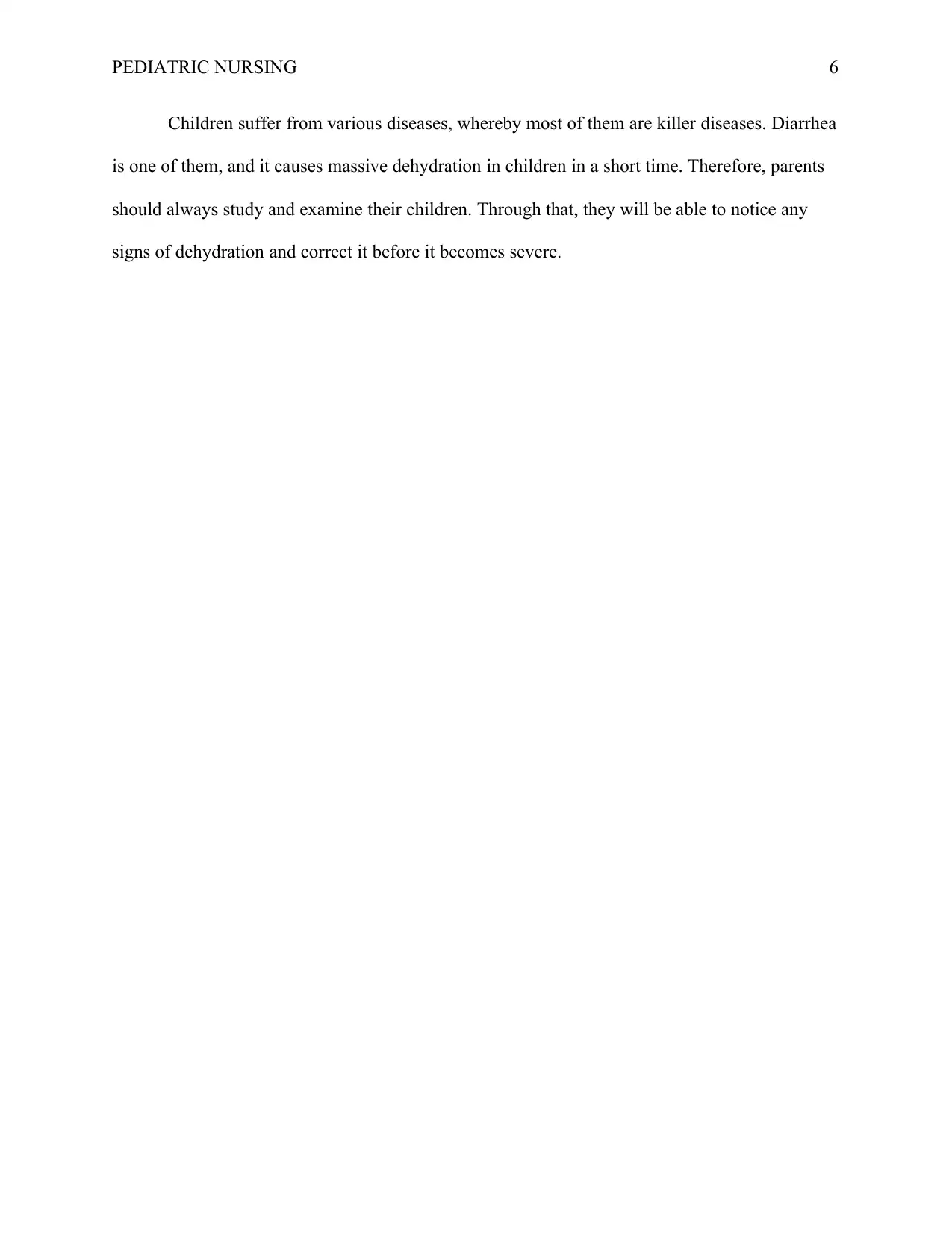
PEDIATRIC NURSING 6
Children suffer from various diseases, whereby most of them are killer diseases. Diarrhea
is one of them, and it causes massive dehydration in children in a short time. Therefore, parents
should always study and examine their children. Through that, they will be able to notice any
signs of dehydration and correct it before it becomes severe.
Children suffer from various diseases, whereby most of them are killer diseases. Diarrhea
is one of them, and it causes massive dehydration in children in a short time. Therefore, parents
should always study and examine their children. Through that, they will be able to notice any
signs of dehydration and correct it before it becomes severe.
⊘ This is a preview!⊘
Do you want full access?
Subscribe today to unlock all pages.

Trusted by 1+ million students worldwide
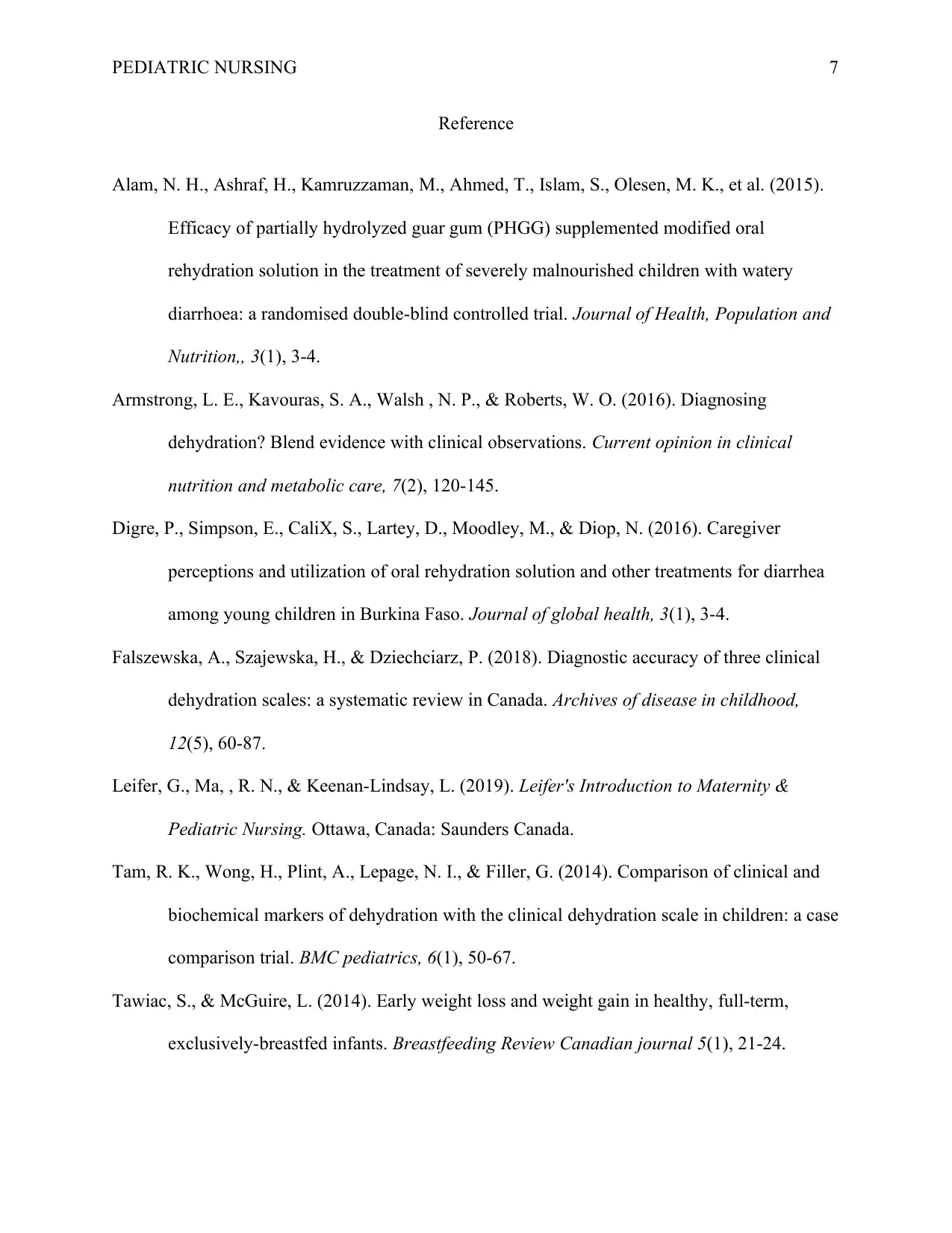
PEDIATRIC NURSING 7
Reference
Alam, N. H., Ashraf, H., Kamruzzaman, M., Ahmed, T., Islam, S., Olesen, M. K., et al. (2015).
Efficacy of partially hydrolyzed guar gum (PHGG) supplemented modified oral
rehydration solution in the treatment of severely malnourished children with watery
diarrhoea: a randomised double-blind controlled trial. Journal of Health, Population and
Nutrition,, 3(1), 3-4.
Armstrong, L. E., Kavouras, S. A., Walsh , N. P., & Roberts, W. O. (2016). Diagnosing
dehydration? Blend evidence with clinical observations. Current opinion in clinical
nutrition and metabolic care, 7(2), 120-145.
Digre, P., Simpson, E., CaliX, S., Lartey, D., Moodley, M., & Diop, N. (2016). Caregiver
perceptions and utilization of oral rehydration solution and other treatments for diarrhea
among young children in Burkina Faso. Journal of global health, 3(1), 3-4.
Falszewska, A., Szajewska, H., & Dziechciarz, P. (2018). Diagnostic accuracy of three clinical
dehydration scales: a systematic review in Canada. Archives of disease in childhood,
12(5), 60-87.
Leifer, G., Ma, , R. N., & Keenan-Lindsay, L. (2019). Leifer's Introduction to Maternity &
Pediatric Nursing. Ottawa, Canada: Saunders Canada.
Tam, R. K., Wong, H., Plint, A., Lepage, N. I., & Filler, G. (2014). Comparison of clinical and
biochemical markers of dehydration with the clinical dehydration scale in children: a case
comparison trial. BMC pediatrics, 6(1), 50-67.
Tawiac, S., & McGuire, L. (2014). Early weight loss and weight gain in healthy, full-term,
exclusively-breastfed infants. Breastfeeding Review Canadian journal 5(1), 21-24.
Reference
Alam, N. H., Ashraf, H., Kamruzzaman, M., Ahmed, T., Islam, S., Olesen, M. K., et al. (2015).
Efficacy of partially hydrolyzed guar gum (PHGG) supplemented modified oral
rehydration solution in the treatment of severely malnourished children with watery
diarrhoea: a randomised double-blind controlled trial. Journal of Health, Population and
Nutrition,, 3(1), 3-4.
Armstrong, L. E., Kavouras, S. A., Walsh , N. P., & Roberts, W. O. (2016). Diagnosing
dehydration? Blend evidence with clinical observations. Current opinion in clinical
nutrition and metabolic care, 7(2), 120-145.
Digre, P., Simpson, E., CaliX, S., Lartey, D., Moodley, M., & Diop, N. (2016). Caregiver
perceptions and utilization of oral rehydration solution and other treatments for diarrhea
among young children in Burkina Faso. Journal of global health, 3(1), 3-4.
Falszewska, A., Szajewska, H., & Dziechciarz, P. (2018). Diagnostic accuracy of three clinical
dehydration scales: a systematic review in Canada. Archives of disease in childhood,
12(5), 60-87.
Leifer, G., Ma, , R. N., & Keenan-Lindsay, L. (2019). Leifer's Introduction to Maternity &
Pediatric Nursing. Ottawa, Canada: Saunders Canada.
Tam, R. K., Wong, H., Plint, A., Lepage, N. I., & Filler, G. (2014). Comparison of clinical and
biochemical markers of dehydration with the clinical dehydration scale in children: a case
comparison trial. BMC pediatrics, 6(1), 50-67.
Tawiac, S., & McGuire, L. (2014). Early weight loss and weight gain in healthy, full-term,
exclusively-breastfed infants. Breastfeeding Review Canadian journal 5(1), 21-24.
Paraphrase This Document
Need a fresh take? Get an instant paraphrase of this document with our AI Paraphraser

PEDIATRIC NURSING 8
1 out of 8
Related Documents
Your All-in-One AI-Powered Toolkit for Academic Success.
+13062052269
info@desklib.com
Available 24*7 on WhatsApp / Email
![[object Object]](/_next/static/media/star-bottom.7253800d.svg)
Unlock your academic potential
Copyright © 2020–2025 A2Z Services. All Rights Reserved. Developed and managed by ZUCOL.





